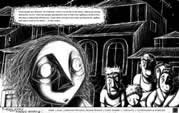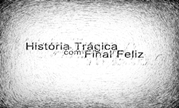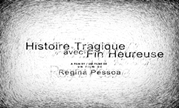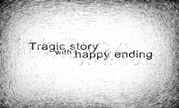Beatriz Scripts.
Regina Pessoa was born in Coimbra in 1969, and graduated in Painting from the School of Fine Arts in Oporto in 1998.
She attended several animation studios, and most particularly that of Cinanima, led by Rodolfo Pastor, learning about storyboard and film (cutting techniques) in 1992; Estagio de Animação (Design and Volume) a co-production between the Filmografo (Portugal) and Lazennec Bretagne (France) studios in 1993 / 4; and Cartoon Master “How to Present a Project”, in Asolo, Italy, in 1995. In 1995, she also participated in Espace Projects – Annecy, with the “A Noite” project.
The determining period in her life was the year 1992, during which she started work at Filmografo – Studio for the Cinema of Animation in Oporto. She worked there, as an animator, on the film “Os Salteadores” [The Brigands], by Abi Feijo – 92 / 3; she then did the animation and graphic design for the film “Fado Lusitano” [Portuguese Music] by Abi Feijo – 94 /5; and also the animation for the film “Clandestino” [Clandestine], another work by Abi Feijo – 99 / 2000.
As an animator, she worked on various films, among them “Ciclo Vicioso” [Vicious Cycle] (1996), which formed part of Glaxo Wellcome’s campaign against the dangers of tobacco, which she co-directed with Abi Feijo and Pedro Serrazina. That was followed by “Estrelas de Natal” [Christmas Stars] (1998) for RTP, co-directed by Abi Feijo, and “A Noite” [The Night] (1999) which despite being only a short, received a commercial release, and was included by the Court Metrage Francaise Agency (France) as a complement to their full length films, and was shown on television by RTP in Portugal and on Canal + in Spain. She then made “Odisseia nas Imagens” [Voyage among Images] (2001), the film that opened the Festival of the same name in 2001.
“A Noite”, the first short film she made on her own, was chosen for more than 80 Festivals and International Cinema Exhibitions, both in competition and as part of retrospectives or special participations. With this film, the director won more than a dozen national and international prizes. Among them, highlights are the Prize for Young Portuguese Filmmaker, and an Honourable Mention from the International Jury and another from the Portuguese Cartoon Prize at the International Festival of the Cinema of Animations of Espinho-Cinanima in 1999, the Prize for Best Animated Film at the Badajoz Cinema Festival in 2000, and Honourable Mention by the Young Jury, in Dresden, Germany, in 2000, the Faro Jury Award, at the Ulisses International Film and Television Festival for Children, 2000, in Portugal, the “Massimo Troisi” European Prize at the 3rd Tyrolean Cinematographic Competition, 2000, in Italy, and the Animated Short Film Prize, European Cinema and TV, 2000, in Viarregio, Italy.
Her film “Histora Tragica com Final Feliz”, recently finished in 2004 – (unfortunately, it still isn’t finished….. I hope that it will be in 2005. Therefore, I think that it will be better to say something general: in production or to be finished in 2005), has already received the SACD Prize, the ARTE Prize and the GTS Prize in the Espace project competitions, the International Festival of Animated Cinema in Annecy, France, in 2001, and was selected for production under the terms of the “Artist in Residence” programme at the French Animation Studio “Folimage”. It was made as a co-production between three countries: France (Folimage), Canada (National Film Board) and Portugal (Ciclope).
Biographic Details / Relationship with Oporto.
I lived out in the country, in a village close to Coimbra, until I was 17 years old. My universe was a rural one. We didn’t have television, which at the time was a major drawback, but today, looking back on it, I think it saved me. In our free time we thought, read, and listed to older people tell stories.
And we also drew. My uncle encouraged us to draw on the whitewashed walls and the doors of my grandmother’s house, with charcoal. The fact that we were drawing there, on the walls, and were encouraged to do so by an adult, gave us a feeling of freedom and also of great availability, because, on one hand, we didn’t have paper or pencil, we always fixed up some walls or doors (Maybe this stayed in my unconscious, because later on I made a film that was engraved on plates of white plaster!)
Then, one day, for various reasons, I left the village and came to Oporto. One of those reasons was that I really wanted to study art. I was 17 years old and I came from the country. I nearly died of fear when I got to the city, I felt lost, and I thought that all my future colleagues were much more advanced than I was.
But little by little I found my place, which I had never had before, back there where I had come from. And for the first time I felt valued for what I did and for the experiences that I brought with me. From the people that I got to know, I learned that my banal experiences could turn into stories, and that these stories could interest people!
I feel very affectionate towards Oporto: it was a city that accepted me and adopted me and where I feel at home today. I will always have “my village”, but Oporto is “my city”.
How I got into Animation
I moved into the field of animation by chance: at the end of the second year of the Fine Arts course, I needed to find work that would allow me to continue to study. In July 1992, I went down to Filmografo with some drawings tucked under my arm, looking for work. On the following day, I had one of the principal characters of “Os Salteadores” [The Brigands] to animate…. And from that day on, animation has been more than just my profession; it has been my chosen life.
By a profession, I mean that some people work from nine to five, and do it to get a salary. Then, once their working day is over, they feel relieved and go home to their house where, finally, they can live their real lives.
The chosen life that I refer to is more like making a sometimes very difficult choice: it implies the acceptance of a professional situation that can rule over the whole of our personal life, invading it, limiting it and affecting it.
The fact that I have chosen to work in Animation means that I have accepted a fragile financial situation and an uncertain future. It also means that I am forced to stay awake, because sometimes the working day goes on into the night, and at other times, the weekend doesn’t exist, or years pass without taking a holiday.
We frequently come across crises, self-doubt and questions arise, and we feel like giving up and abandoning everything. At those moments, it always helps me to remember a phrase that Abi said to me one day: “If you think you have something to say, trust in yourself and fight for it. If it is really important to you, dedicate yourself passionately to it and this will show in the end result. The people who come to the film will feel it too, in some way.”
It was the most important lesson that I have ever learnt, and I think that it will always be useful through the rest of my life.
The present.
When I finished my first and, to date, only film, “A Noite”, back in the 1990s, I was living at a prosperous time in Portuguese Animation, and the future was full of optimism. There was a good general recognition, specifically on the part of ICAM. The government support appeared to be sure, and was on an increasing trend.
Today, things are not like that. The atmosphere that I feel around me is one of uncertainty and insecurity.
At the moment, I am finishing a film, but I constantly ask myself whether I will have an opportunity to make another one, one day.
Someone recently said to me that the people who are dedicated to making Animated Short Films, are a “species on the road to extinction”, which is not very encouraging. I continue to believe that the Short is an ideal format for Animation: it has a duration that lends itself well to the means and type of narrative used; it’s a privileged field in terms of experimentation with new visual, graphic and technical methods, amongst others, whose results others in the industry (those making full length films, series, etc.) can utilise.
I will continue to try to work in animation, and to make other short films, I have ideas that I would like to develop and methods that I haven’t yet learned that I would like to experiment with,
In the meantime, in the current perspective, it doesn’t look as though it’s going to be very easy. It appears very likely that I will have to dedicate myself to other activities in order to survive.






